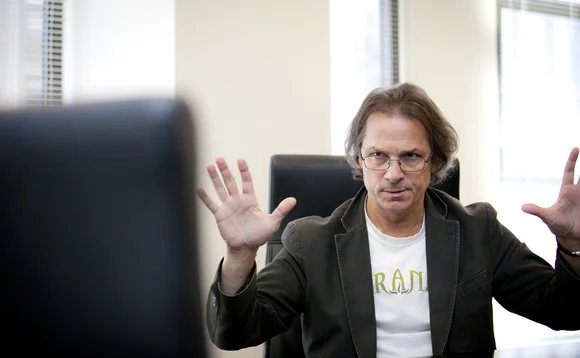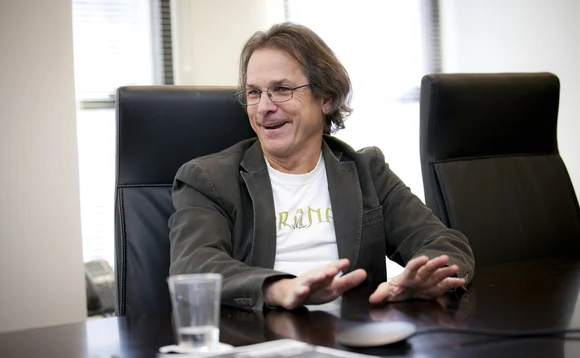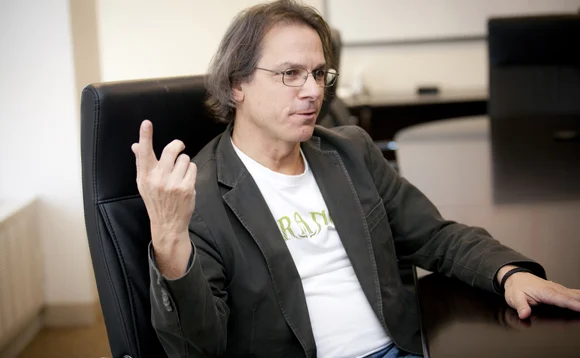Well-Suited: Steve Ellis Merges Wells Fargo, Wachovia IT






Rising before dawn as usual, Steve Ellis flipped on his phone for news about Wachovia. The wires had been buzzing for more than a week as the country’s fourth-largest bank teetered on the brink of insolvency. Though Wachovia had already been shoehorned by the Federal Deposit Insurance Corp. (FDIC) into a tentative purchase agreement with Citigroup, it remained in talks with Ellis’ bank, Wells Fargo. So Ellis had to keep checking the news. What he saw in the dark Friday hours of Oct. 3, 2008 made his heart sink faster than Wachovia’s stock price.
Ellis had been part of the due diligence group that investigated the possibility of buying Wachovia when it began to fail in the last week of September 2008. The deal appeared dead when Citi stepped in with a formal $2.16 billion bid, in addition to $12 billion paid to the FDIC. Only one executive at Wells Fargo was left smiling. Ellis wanted no part of that merger. In particular, he wanted no part of the platform integration that such a merger would entail. “I knew what it was going to be,” he says. “Hell.”
Ellis thought Citi had saved his bacon. It hadn’t. Wells Fargo, on the morning of Oct. 3, triumphantly announced that it had snatched up the East Coast bank for $15.1 billion. Ellis dialed David Hoyt, his boss and a senior executive vice president.
“You want to run the merger, don’t you?” Hoyt asked.
“Nope,” Ellis replied.
Hoyt was silent. Several seconds passed.
“No, you really do, don’t you?”
“You bet I do!” Ellis groaned.
The sun hadn’t even had time to come up before Ellis was pulled into the longest and most complicated project of his career. The merger was like a singularity at the core of a massive black hole: Nothing escaped. As much as he grimaced at the thought, Wells Fargo’s group head of wholesale services knew he wasn’t getting out of it.
Walls between banking platforms, between two corporate cultures, needed to be torn down. Who better to do it than a man who had already flouted his own corporate culture, and who had already torn down the notions of what was possible with banking technology?
‘That Guy? Are You Sure?’
It took Ellis three years to get used to wearing a suit and three minutes to get used to not wearing one. Confident in his position at the San Francisco-based bank, he’d dumped his business threads for good in the late 1990s.
In 2001, though, he was slated to present to the bank board the progress he’d made spearheading an internet portal, and after some deliberating, decided he should throw on a jacket and tie. He’d crossed paths with then-CEO Dick Kovacevich a handful of times but the two were not close. He wasn’t sure how Kovacevich would take his standard ensemble of jeans, Birkenstock sandals and an earring.
At the board meeting, Kovacevich introduced him by saying, “We were going to have Steve talk about the internet, and that guy looks like Steve, but I’ve never seen him in a suit before so I don’t know who that is.” That was the last time he wore a suit.
Hair reaching down to a collar that is flipped half inside-out, his manner unpolished and conversational, Ellis, 57, looks every bit the bank executive—as long as “bank” is replaced with “organic farm collective.” Folk singers might consider him underdressed. He fits the mold of a Waters profile subject about as well as Dora the Explorer.
“When clients see him, sometimes they don’t think he’s as senior as he is,” says co-worker David Trotter. “He comes across more as an operations guy or something. You have to prep them sometimes, or as the meeting goes along, help them to understand that he runs the world. But once he opens his mouth and starts talking, his credibility is instant.”
There’s a reason he’s been in the same place for a quarter of a century, managing 7,000 people in San Francisco, Charlotte, Minneapolis, and India. Wells Fargo allows a man in sandals to “run the world” because he’s earned that trust with his innovation, particularly on three major projects that have helped turn the bank into the nation’s largest by market cap.
Ellis didn’t plan to stay at one institution for 25 years. Career plans are a waste of time, he says, because every time he makes a five-year plan in business, he ends up throwing it out.
Raised in Philadelphia and schooled at Pennsylvania State University, he went west in 1976 to watch the sun set over the Pacific Ocean, and never came home again. His pockets empty, he took a job tending bar at the Produce Row Café in Portland, Ore., only to buy the place two years later with six friends. He tooled around Portland for nine years before deciding he’d drunk one too many 8 a.m. pints, and enrolled in a quantitative analytics MBA program at the University of Oregon. The school had a pipeline to Wells Fargo, and his then-wife had family in San Francisco, the bank’s base of operations, so a job there seemed like a good temporary fit.
Ellis started at Wells Fargo in 1987 in the corporate finance division doing derivative modeling and forecasting the balance sheet. In 1989, the bank moved him to commercial real estate, then a few years later to loan operations. After that, it was on to wholesale, where he was made CFO. When some trouble arose in the treasury management division during a 1996 takeover of First Interstate Bank, he was transferred there to help out.
The First Big Ideas
In April of 1999, Ellis went to a conference at which Scott McNealy, the co-founder of Sun Microsystems, was showing what at the time seemed like a magic phone. It could connect with other devices and do transactions and had a smart card in it. “It was like a thunderbolt,” Ellis says. “Wow! That is the world of tomorrow and it’s here right now and we’ve got to get with it.”
In a mad rush he pulled five employees together and had them catalogue everything Wells Fargo was doing or planning or even thinking about the still-underdeveloped internet. That information was converted into a white paper that he presented at a trade show at which Kovacevich and Hoyt happened to show up at the last minute. What they heard was the future. They created an enterprise internet working group and installed Ellis to lead the wholesale branch.
The first rule of his 25-person team was “date-hard, functionality-soft.” It would be a fluid design, so they reasoned that time-to-market superseded perfection in a product that would be changed 100 times anyway. The site would go beyond information distribution: It would allow customers to move tens of millions of dollars globally with a few clicks. It would be a single sign-on portal with strong authentication procedures. They rejected existing technology because it was too rigid; the plan was to rebuild using open source technology every 90 days based on customer feedback. Forty-nine releases later, that plan is still in place.
Six months on and the Commercial Electronic Office, or CEO, was born. Its first deal, in June of 2000, was a foreign exchange (FX) transaction. It would become a model for other banks’ online commercial banking portals and earn Ellis accolades in the book Collaborate or Perish! by Zachary Tumin and William Bratton.
Interestingly, the finished product wasn’t what Ellis was expecting. The website didn’t include a bunch of new functionality as he imagined it would. It just allowed customers to do what they were already doing, but faster and smarter.
In 2007, he found inspiration again. Phones are computers now, he explained to his boss. People are going to start banking through them. “What does that mean for us?” Hoyt asked.
“I don’t know,” Ellis answered. “But give me $5 million and I’ll find out.”
Who could refuse an offer like that? Ellis got his money and rewarded Hoyt with the industry’s first commercial banking program delivered through a mobile device.
Wells, Meet Wachovia
Those were projects that got Ellis’ juices flowing. He was doing things that hadn’t been done before, seizing new technology and fusing it with big ideas. The Wachovia integration did not fit that description. After his experience on the First Interstate merger in 1996—“the worst merger in the history of banking,” he says—Ellis wanted no part of any others. The CEO project had gotten him out of a merger with Norwest, but with Hoyt on the phone on Oct. 3, 2008, he couldn’t think of another revolutionary technology idea to get him out of the Wachovia assignment.
At that moment, he’d have been wise to remember some advice he received when he took up surfing—you can’t give the board away the first day, because the first day is really painful.
Not only were the two banks enormous, they covered different segments of the market. That’s good for business but bad for technologists. Wachovia Securities managed over $1 trillion—number three in the US behind Merrill Lynch and Citi. Wells, by contrast, was a niche player in the capital markets. Even though Wells’ wholesale department included investment banking, Ellis needed a crash course to catch up.
“That’s a place where technology and business really connect,” he says. “If you’re a developer, capital markets products require you to understand them, whereas if I’m a Java programmer, I can work on almost anything.”
Despite the well-chronicled derivatives mistakes Wachovia had made before the financial crisis, Ellis was impressed with the personnel on the investment banking side. One of those people was Leigh Ferrante, now CTO of Wells Fargo Treasury Management Technology.
“He breaks every stereotype that someone like me—coming from a bank that was more traditional, conservative, and formal—had,” Ferrante says. “The culture at Wachovia was more hierarchical, top-down in the way communications rolled out. Certainly in our appearance, the way we dressed, it was very different. I remember meeting Steve and honest to goodness didn’t even realize at which level in the organization he was. But I felt very at ease, because he’s a very comfortable, at-ease kind of person.”
Employees weren’t even allowed to wear jeans on the executive floors at Wachovia, and here was a man who exclusively wore jeans and who was her new liaison to the executives. Plenty of Wachovians were taken aback.
“The first time he walked on stage in Charlotte dressed in Birkenstocks, jeans, and a sweater from a secondhand store in front of 300 clients, you think: ‘I don’t know how this is going to go,’” says Trotter, the head of treasury management sales and marketing and another Wachovia transfer. But his new joint team recognized his leadership right away. He was adept at managing diplomacy between the two groups and inserted several Wachovians into positions of power. His technical expertise, for someone in a management position, commanded respect. It helped settle a chaotic situation in which the newcomers were still shaken by everything that had happened to their company. Including the brief fling with Citi, he was their third boss in less than a month.
The Three-Year Slog
The worst part of the platform integration was how long it took. Not long into the first meetings, they realized it would take a year to map everything out, another year to build the go-forward platform, and another to migrate all the accounts. This meant running twin platforms in parallel.
“It’s not only that it’s the biggest merger in US banking history and that it’s complex, because at legacy Wachovia, we had many longstanding corporate customers with whom we had done a lot of customization that needs to deciphered, but in addition to all that we have multiple parallel strings of process,” Ferrante says. “You’re working through your infrastructure and making sure you’re building out all that infrastructure to support the volume and capacity. You’ve got to develop functionality in the go-forward platform that customers are used to. That’s a lot of work on the back-end to make sure the customer experience is close to what it was.”
It affected the business as well. Should new East Coast clients be onboarded onto the Wachovia or the Wells Fargo platform? Did both platforms meet the new regulatory requirements that sprung out of the crisis?
Meanwhile, the two treasury platforms turned out to have 1,000 differences. Fusing the two into a coherent whole turned out to be “a combination of quantum physics and tarot card reading.” Yet building the new entity was one of the simpler parts; the hard part was migrating the accounts and coordinating with the other teams at the bank. Most customers weren’t hard to move, but about 5 percent were incredibly complicated because their accounts were so highly customized.
While drawing up the proposed budget, Ellis made a bet with Debbie Ball, the leader of the overall integration and now COO of Wells Fargo International Group, about whether the overall cost would run more or less than half a billion dollars.
The biggest merger Wells Fargo had ever done cost $150 million, so Ellis tripled that and pegged the cost at slightly under the half-billion mark, which he submitted to the higher-ups. Months later, he realized he’d undershot, and had to ask his boss for another $100 million. Three weeks later, the total was up to $750 million. Not six weeks went by before he had to admit that this still wasn’t enough. “I go back to Dave Hoyt, and he’s pissed. But Dave never yells at you. He just breathes heavy. So he wants to know the final number. And I said, ‘I really don’t know. It could be more, could be less.’”
By the time the project wrapped in February this year, the bill read $1 billion. Ellis still hasn’t paid Ball.
The new platform uses about 85 percent Wells Fargo technology and 15 percent Wachovia, he says. The only thing left to do now is shut down the two legacy platforms. He considers it a success because there was no customer attrition and no one died.
Now that they’re operating on a single platform, Wells Fargo and Wachovia are unified in every way. Ellis puts 250,000 miles a year on his suitcase, meeting with customers of the new monolith, explaining the merits of the technology he designed. With his increased visibility in the capital markets, could Wall Street start trading in its briefcases for surfboards?
Not a chance, says Trotter. “One thing I make sure of is that my salespeople know there’s only one Steve Ellis and they’re not to copy him.”
Corporate culture isn’t quite ready to be “Ellis-ed,” it seems. Now straighten that tie.
Only users who have a paid subscription or are part of a corporate subscription are able to print or copy content.
To access these options, along with all other subscription benefits, please contact info@waterstechnology.com or view our subscription options here: https://subscriptions.waterstechnology.com/subscribe
You are currently unable to print this content. Please contact info@waterstechnology.com to find out more.
You are currently unable to copy this content. Please contact info@waterstechnology.com to find out more.
Copyright Infopro Digital Limited. All rights reserved.
As outlined in our terms and conditions, https://www.infopro-digital.com/terms-and-conditions/subscriptions/ (point 2.4), printing is limited to a single copy.
If you would like to purchase additional rights please email info@waterstechnology.com
Copyright Infopro Digital Limited. All rights reserved.
You may share this content using our article tools. As outlined in our terms and conditions, https://www.infopro-digital.com/terms-and-conditions/subscriptions/ (clause 2.4), an Authorised User may only make one copy of the materials for their own personal use. You must also comply with the restrictions in clause 2.5.
If you would like to purchase additional rights please email info@waterstechnology.com
More on Emerging Technologies
DTCC tests 24x5 trading, State Street launches digital asset platform, and more
The Waters Cooler: STG carves out S&P Global’s data businesses, Arcesium expands in Hong Kong, and Rimes partners with three vendors in this week’s news roundup.
Banks split over AI risk management
Model teams hold the reins, but some argue AI is an enterprise risk.
Waters Wavelength Ep. 344: Hot topics for 2026
Tony and Shen preview some of the topics they think will be big this year.
Fintechs grapple with how to enter Middle East markets
Intense relationship building, lack of data standards, and murky but improving market structure all await tech firms hoping to capitalize on the region’s growth.
SimCorp–MSCI expand partnership, quantum exploration, Dora concerns, and more
The Waters Cooler: Droit launches GenAI regtech tool, bids for EU OTC derivatives tape open, and more in this week’s news roundup.
The quantum leap: How investment firms are innovating with quantum tech
While banks and asset managers are already experimenting with quantum computing to optimize operations, they should also be proactive in adopting quantum-safe strategies.
‘The end of the beginning’: Brown Brothers Harriman re-invents itself
Voice of the CDO: Firms who want to use AI successfully better start with their metadata, says BBH’s Mike McGovern and Kevin Welch.
2026 will be the year agent armies awaken
Waters Wrap: Several AI experts have recently said that the next 12 months will see significant progress for agentic AI. Are capital markets firms ready for this shift from generative AI to agents?







